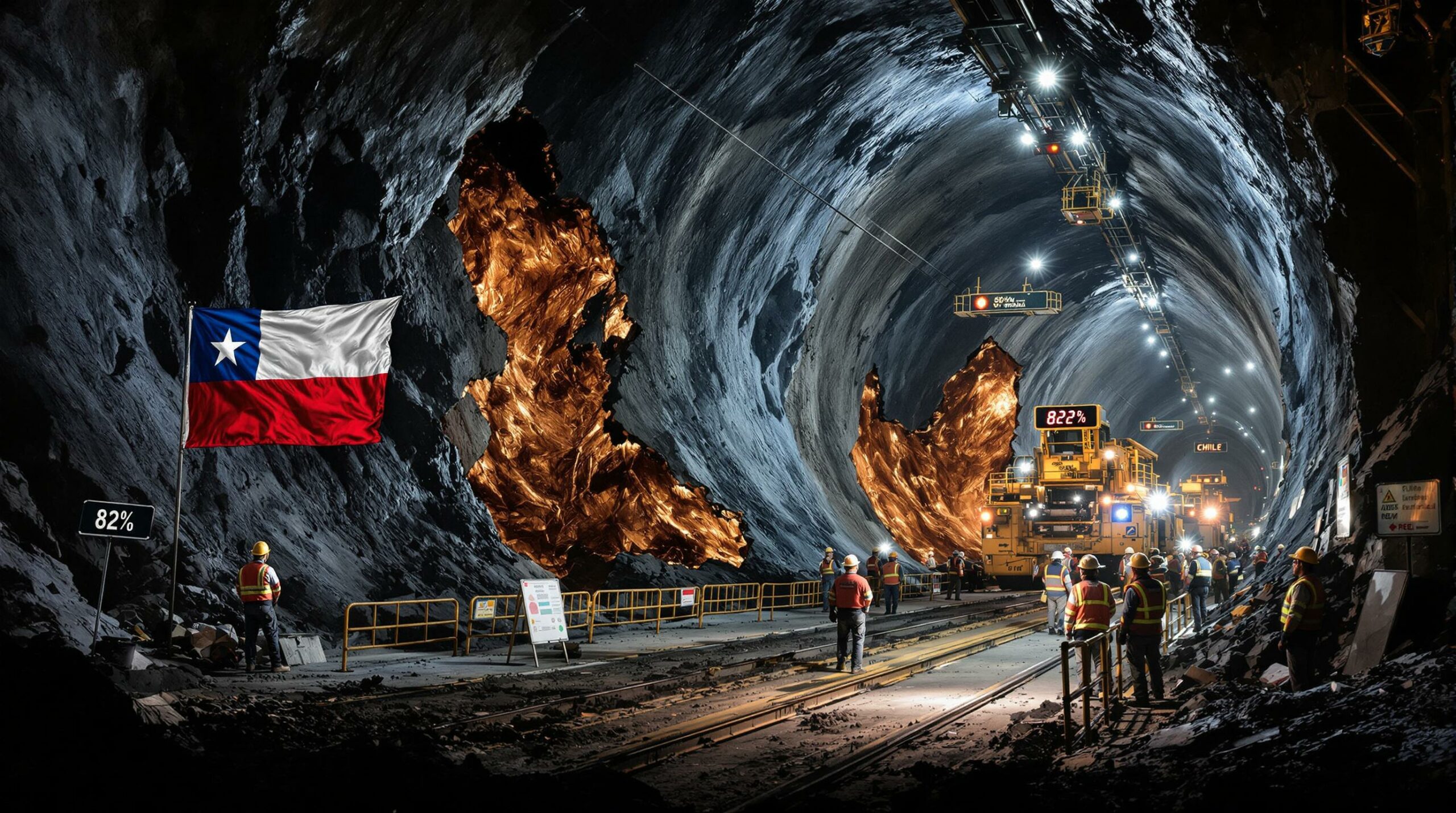Codelco Begins Gradual Restart at Chile Mine Hit by Collapse
On July 31, 2025, Chile's state-owned copper mining giant Codelco faced its deadliest mining disaster in decades when a catastrophic collapse at the El Teniente mine claimed the lives of six workers. Initially underestimated in scope, recent inspections have revealed the true extent of the damage – approximately 3,700 meters (12,000 feet) of tunnel infrastructure destroyed, nearly five times greater than Codelco's preliminary assessments indicated.
After thorough safety evaluations conducted by mining and labor authorities, Codelco has now implemented a carefully structured "Safe and Gradual Return Plan" to resume operations while maintaining rigorous safety protocols in the affected areas. This approach aligns with broader mining industry evolution trends emphasizing worker safety and sustainable practices.
The Collapse: Scale and Impact
The collapse at El Teniente – Codelco's largest copper-producing mine and a crucial contributor to Chile's position as the world's leading copper producer – sent shockwaves through the global mining industry. The disaster not only resulted in tragic loss of life but also dealt a significant blow to a company already struggling with production challenges.
"This incident represents one of the most serious safety events in recent years for Chile's mining sector," noted Mining Minister Aurora Williams in a recent press conference. "The government is closely monitoring the recovery efforts and investigation to ensure both worker safety and the stability of our copper production."
The Public Prosecutor's Office investigation has revealed that the damage far exceeded initial estimates. While the investigation into the precise cause continues, preliminary reports suggest that mining activities rather than natural geological events may have contributed to the collapse.
Restart Strategy and Production Impact
Operations officially resumed over the weekend of August 10-11, with eight underground areas deemed safe after comprehensive inspections. The operational smelter has also been reactivated, allowing for continued processing of extracted materials.
"The eight [areas] that are opening represent approximately 82% of production, and the recovery is gradual," Mining Minister Williams explained in a Radio ADN interview on August 11. This phased approach prioritizes worker safety while minimizing production disruption.
Four sections of the mine remain off-limits to workers as investigations continue. Notably, these closed sections include newer parts of the deposit that are considered critical for future production plans. The timeline for fully restoring operations across these areas remains uncertain, pending completion of safety assessments and potential infrastructure repairs.
Leadership Changes and Organizational Response
In the wake of the disaster, El Teniente division head Andrés Music has departed, with operations manager Claudio Sougarret stepping in on an interim basis. Codelco has emphasized that this leadership transition is strategic rather than punitive.
"This decision is not a response to the assignment of any responsibility, but rather stems exclusively from the need to focus the division's attention on the challenges posed by the implementation of the Safe and Gradual Return Plan," Codelco stated in an official communication.
The company's response highlights the delicate balance between maintaining production targets and ensuring worker safety – a tension that has characterized Chile's mining industry throughout its history.
Safety Protocol Reassessment and Industry Implications
The El Teniente collapse will likely trigger far-reaching safety reassessments throughout Chile's mining sector and potentially across global mining operations. The incident raises important questions about tunnel support systems, real-time monitoring technologies, and emergency response protocols.
"When a disaster of this magnitude occurs, it typically leads to a comprehensive reevaluation of industry-standard safety practices," explains mining safety expert Carlos Fuentes. "The disparity between initial damage estimates and the actual extent of destruction points to potential gaps in structural assessment methodologies that need addressing."
Mining companies across Chile may face increased regulatory scrutiny and pressure to implement more rigorous safety measures. For an industry that balances production quotas with worker protection, this incident serves as a stark reminder of the consequences when safety systems fail.
Technical Challenges in Recovery
The recovery process at El Teniente faces significant technical challenges beyond just clearing debris. Mining engineers must assess:
- Structural integrity of adjacent tunnels and support systems
- Potential weakening of surrounding rock formations
- Water management systems and potential flooding risks
- Ventilation network damage and reconstruction requirements
- Secondary collapse risks during repair operations
These technical considerations explain why recovery must proceed gradually, with each section undergoing comprehensive safety verification before workers can return. Additionally, advanced 3D geological modelling trends are being employed to better understand the structural damage and plan recovery efforts.
Economic Implications for Codelco and Chile
For Codelco, the timing of this disaster couldn't be worse. The company has been grappling with a years-long production slump while simultaneously facing the need for significant capital investments to maintain aging mines and develop new projects.
The financial implications extend beyond immediate repair costs:
- Infrastructure Reconstruction: Rebuilding 3,700 meters of damaged tunnels represents a substantial capital expenditure
- Production Shortfalls: The 18% reduction in operational capacity directly impacts revenue streams
- Future Development Delays: The affected newer sections were crucial for maintaining production levels in coming years
- Increased Safety Investments: Additional safety measures will likely increase operational costs
Strategic Importance of El Teniente
El Teniente holds particular significance in Codelco's portfolio as the company's largest copper producing mine. Located about 80 kilometers south of Santiago, the century-old operation has been a cornerstone of Chile's mining industry.
The mine features:
- Underground operation spanning hundreds of kilometers of tunnels
- Production capacity exceeding 400,000 tonnes of copper annually
- Employment for thousands of workers across direct and contractor positions
- A complex ventilation and transportation network
- Critical infrastructure for Chile's copper export industry
Any prolonged disruption at this single site can significantly impact national economic indicators given copper's importance to Chile's export economy, as highlighted in recent copper price insights.
National Economic Context and Copper Markets
Chile's position as the world's largest copper producer makes the El Teniente situation relevant far beyond the company's balance sheet. Copper represents approximately 10-15% of Chile's GDP and roughly half of its export value, making any significant disruption a matter of national economic security.
The incident comes at a time when:
"Global copper markets are already dealing with supply constraints from various regions, increasing the importance of stable production from major producers like Chile. Extended disruptions at significant mines like El Teniente can influence global copper pricing and availability, particularly for industrial consumers in manufacturing and construction sectors." – International Copper Study Group analyst report, August 2025
While the 82% operational capacity represents a significant recovery, market analysts will be watching closely for any signals regarding the timeline for full restoration, particularly as it relates to the newer sections critical for maintaining production levels. The situation also impacts the global copper supply forecast for the remainder of 2025.
Regulatory Response and Government Oversight
Chile's Public Prosecutor's Office is actively investigating the incident, examining potential regulatory compliance issues and determining whether appropriate safety protocols were followed. Mining Minister Aurora Williams has emphasized the government's commitment to both worker safety and maintaining Chile's position in global copper markets.
Potential regulatory outcomes could include:
- Enhanced tunnel inspection requirements
- More frequent safety audits of aging mine infrastructure
- Stricter reporting requirements for potential structural issues
- Mandatory implementation of advanced monitoring technologies
- Increased penalties for safety protocol violations
These regulatory developments would impact not just Codelco but all mining operations throughout Chile, potentially increasing compliance costs while enhancing worker protection.
Future Outlook and Industry Lessons
As Codelco works to restore full operations at El Teniente, the mining industry is watching closely for lessons that can be applied to prevent similar tragedies. The most significant takeaway may be the critical importance of accurate damage assessment and transparent reporting following safety incidents.
The discrepancy between initial damage estimates and the actual extent of destruction – nearly five times greater than first reported – raises important questions about assessment methodologies and reporting practices. Future protocols may incorporate more conservative estimation approaches and implement redundant verification systems.
Technology and Innovation in Mine Safety
The incident also highlights the potential role of emerging technologies in preventing future disasters:
- Structural Monitoring Systems: Real-time stress detection in support structures
- Advanced Imaging Technologies: Beyond-visual-range structural assessment tools
- Predictive Analytics: AI-powered systems to identify potential failure points before collapse
- Autonomous Inspection Vehicles: Robotic systems for assessing dangerous areas
- Improved Communication Networks: Enhanced emergency response coordination
These technological solutions, while requiring significant investment, could dramatically improve safety outcomes while potentially preventing the massive financial losses associated with major mine closures. Furthermore, mine reclamation innovation approaches may need to be considered for sections that cannot be safely reopened.
FAQs About the El Teniente Mine Incident
What caused the collapse at El Teniente mine?
The exact cause remains under investigation. Preliminary reports indicate mining activities rather than natural causes may have contributed to the collapse, though authorities have not released official conclusions. The extensive damage – 3,700 meters of tunnel infrastructure – suggests a complex failure mechanism.
How long will it take for El Teniente to return to full production?
While 82% of production has resumed as of August 11, 2025, the timeline for complete recovery remains uncertain. The four closed sections include newer parts of the deposit crucial for future production plans. Recovery timelines for similar incidents historically range from several months to over a year depending on damage severity.
What safety measures is Codelco implementing during the restart?
Codelco is following a "Safe and Gradual Return Plan" developed in coordination with mining and labor authorities. This includes comprehensive structural integrity assessments, enhanced monitoring systems, revised evacuation protocols, and additional safety training for all personnel returning to the mine.
How significant is El Teniente to global copper supply?
El Teniente is Codelco's largest copper mine and contributes significantly to Chile's position as the world's leading copper producer. The mine produces approximately 400,000 tonnes of copper annually, representing a meaningful portion of global supply. Even temporary disruptions can influence global copper market dynamics.
Has Codelco faced similar incidents in the past?
While Codelco has experienced various operational challenges throughout its long history, this incident represents one of the most serious safety events in recent years for Chile's mining sector. The scale of both human loss and infrastructure damage makes this a particularly significant event for the company.
Looking Forward: Balancing Production and Safety
As the mining industry processes the lessons from this tragedy, the central challenge remains balancing production demands with worker safety. For Codelco and Chile's broader mining sector, the path forward requires integrating enhanced safety protocols without compromising the operational efficiency that makes Chilean copper globally competitive.
The gradual restart at El Teniente demonstrates both the resilience of mining operations and the paramount importance of prioritizing human safety over production targets. While the economic implications of this disaster will continue to unfold in coming months, the most lasting impact may be in how it reshapes safety practices throughout the industry.
Disclaimer: This article contains information about an ongoing investigation and recovery efforts. Details may change as new information becomes available. All production estimates and timelines should be considered preliminary until officially confirmed by Codelco or relevant regulatory authorities.
Want to Stay Ahead of Major Mineral Discoveries?
Don't miss out on potential high-growth opportunities in the mining sector. Explore Discovery Alert's dedicated discoveries page at https://discoveryalert.com.au/discoveries/ to learn how their proprietary Discovery IQ model delivers real-time alerts on significant ASX mineral discoveries, giving you the market edge before news becomes mainstream.




